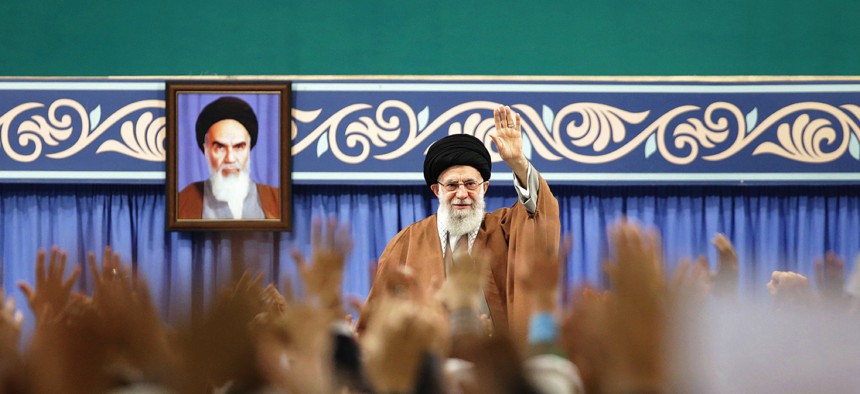
In this picture released by the official website of the office of the Iranian supreme leader, Supreme Leader Ayatollah Ali Khamenei waves to members of the Revolutionary Guard's all-volunteer Basij force in a meeting in Tehran on Nov. 27, 2019. Office of the Iranian Supreme Leader via AP
The Foreign-Policy Parallels Between Trump and the Ayatollahs Are Uncanny
Neither the U.S. president nor Iran's leaders are as willing to go toe-to-toe as they might seem.
It’s hard to imagine two parties more at loggerheads than President Trump and the Iranian leadership. They seem to look for every opportunity to undermine each other and attack each other. The strange thing, though, is they seem to have very similar instincts when it comes to foreign policy. That tendency makes them more combative to each other, but it also has a silver lining. Neither one is nearly as willing to go toe-to-toe as it might otherwise seem.
The parallels are uncanny. To start with the obvious, each side sees surprise as an instrument of leverage, and each actively searches for ways to be unpredictable. In this worldview, slow and deliberate policy processes are for losers—they merely cede advantage to the adversary. Both seek to seize the news cycle, and each seems determined to zig when everyone expects them to zag. Each time one side stuns the world, it is not by accident; it is by design. And it happens over and over again.
In addition, each side is deliberately disruptive. Each is dismissive of the concept of a rules-based international order, which it sees as a conspiracy to deny their country its due. They come to their skepticism from different places: Trump often views foreign countries as freeloaders, benefitting from U.S. protection while contributing little to the common good. Iranians view much of the world as co-conspirators in an U.S.-led effort to weaken, subjugate, and humiliate Iran. Still, they come out in the same place. They see long multilateral deliberations that lead to marginal improvements in coordination, compromise, and the forging of consensus as a trap (and the unilateral U.S. abrogation of the JCPOA has deepened this view). Chaos, on the other hand, offers opportunities. It is much better, each seems to think, to throw things into disarray and see if advantage can be won as the parties struggle to reinstitute stability.
Each side is also relentlessly innovative, too. Iran has invested deeply in asymmetrical forces—everything from military proxies and guerrilla groups to computer hackers—that allow it to go toe-to-toe with superpowers whose conventional forces completely outclass their Iranian counterparts. Iran has designed many of these groups to operate with ambiguity, making it hard for targets to respond decisively. Iran’s unconventional and covert activities help Iran punch well above its weight, often making Iran look like the near peer of a superpower.
Related: Is US Deterrence Against Iran Doomed to Fail?
Related: An End to Magical Thinking in the Middle East
Related: Today, Everyone’s a Nuclear Spy
President Trump, for his part, has completely changed the way people around the world think of the U.S. presidency. He has berated allies and flattered adversaries. The interagency process, which sophisticated observers gauge to predict what the U.S. government will do, has become opaque. The president’s Twitter account seems to leave no mystery as to his thoughts, but the president often does not follow up on his tweets and the relationship between the tweets and U.S. policy is a topic of wide speculation. The president has taken a 240-year-old institution and reshaped it into a weapon to advance his personal instincts and strategies.
Perhaps most importantly, neither the Iranians nor the U.S. president have much interest in pursuing a conventional path to victory. In fact, neither seems to hold a very conventional concept of victory itself. Traditionally, some combination of warfare, confidence-building measures, and lengthy bargaining between countries lead to a sharp decline in tensions. The future is sharply different from the past. But not only do both sides seem to relish a fight; they seem to think that struggle is part of the natural order of things in the past, the present, and the future.
Negotiators often try to sketch out a “zone of possible agreement,” but it is hard to imagine any circumstance under which either Trump or the Iranians would be satisfied with the actions of the other side. This is only partly because each side deeply doubts the intentions of the other side and has concluded that its hostility cannot be slaked. Equally importantly, each side considers conflict as part of the natural order of things, to be embraced with gusto. In this reading of global affairs, there is little to be won from goodwill and no points awarded for good behavior. Interstate relations are a series of thrusts and kicks. To stop fighting is to start to lose.
This is not all as dire as it seems, however. For all of the mutual hostility, neither side seems especially irrational, and each seems eager to calibrate its responses so as not to tumble into war. Damages at this point are to property, not people, and each side seems to be refraining from the sorts of actions that could be misinterpreted as an attack of the other’s forces. Even small moves, like last week’s prisoner swap, are sprinkled throughout. This restraint is no small thing, because it is unclear how either side would end a war—let alone end one successfully—were one to start.
We are left, then, with a situation that is not nearly as bad as it might be—one that should evoke worry but not despair. The two sides are locked in conflict, but conflict is where they seem most comfortable. It is not desirable, but it may prove sustainable, and given the range of possibilities, that may not be a bad thing.




